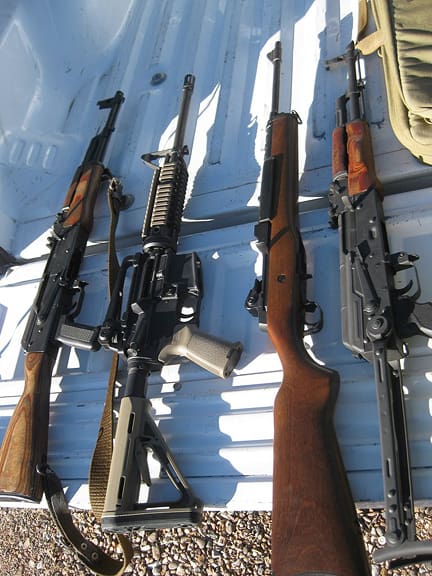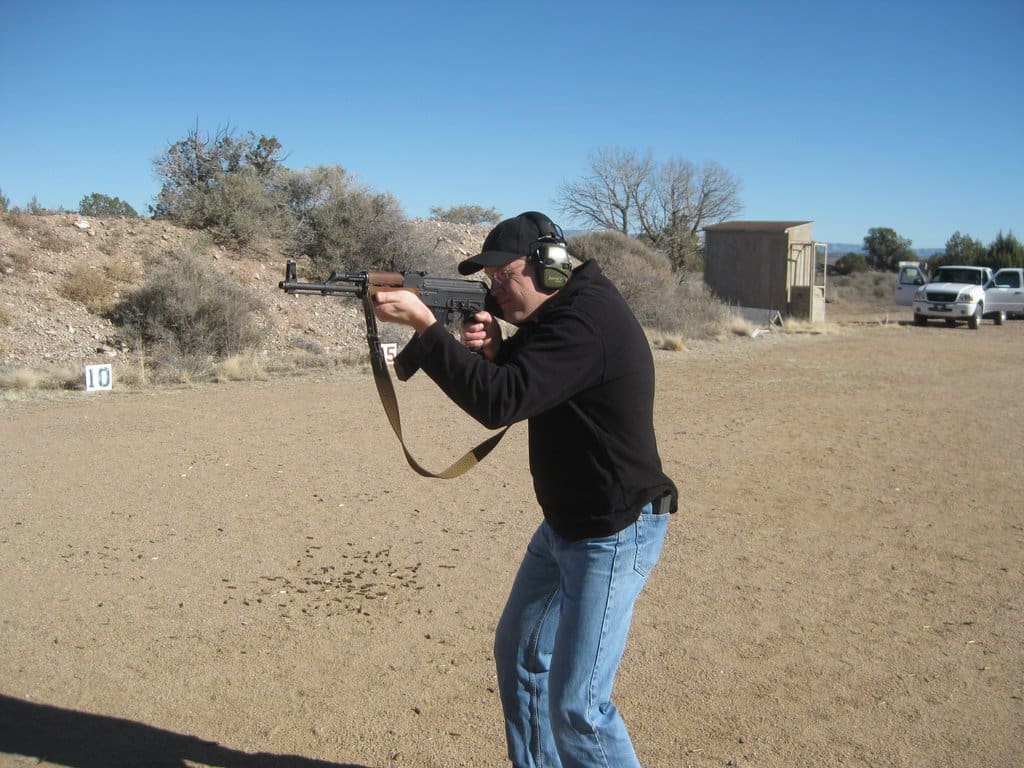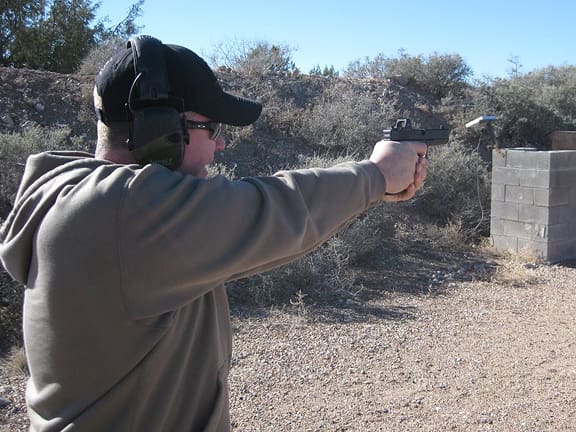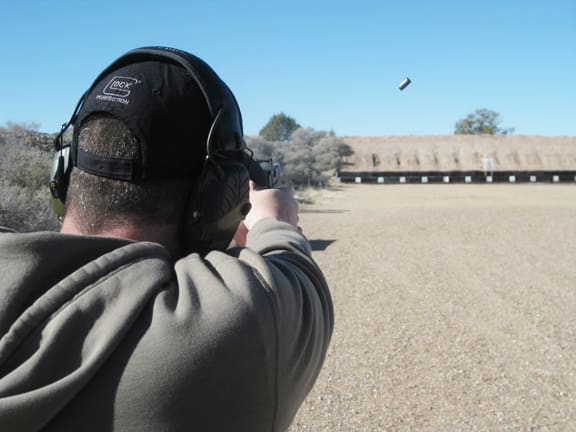I first met Dave Starrin when I took my CCW class at Gunsite about a year ago. The Operations manager at Gunsite was extremely patient with all my OCD questions over the phone in preparation for the class, and for a time afterwords. As I’m fairly local to Gunsite, I asked Dave about the possibility of some private instruction. He told me to come up to visit whenever our schedules allowed. So far, that’s been about an afternoon every other month…
Dave has watched (with amusement, I imagine) as I’ve gone from unarmed victim material to occasionally armed with the smallest possible caliber pocket gun (un-chambered of course), to armed with a full-sized service pistol (chambered and ready to rock and roll), to a reasonably competent pistolero.
Dave’s been an encouraging listener, never forcing me to go any certain way, or pick any certain caliber/platform/carry method. After a year or so, I’ve come to many of the same conclusions about pistols as Dave. I now carry a Glock 9mm all the time. I sort of took the long way around, experimenting before coming to that conclusion. I should have listened in the first place. Sometimes the destination is more important that the journey.
In the next step of my training as a competent armed civilian, I decided to learn how to use a rifle. Not the hole-punching Boy Scout target rifle of my youth. An honest-to-goodness combat rifle.
Before wading into purchasing anything, I met with Dave to try out a few different platforms and see what fits my needs. Like any good salesman, Dave organized our discussions into a series of questions.
First: with what weapon should a civilian be armed? Dave believes we should be competent with three classes of combat weapons: pistol, carbine and shotgun. They each have different roles. Drilling down, for someone looking for minimal training, minimal maintenance and functional equipment, Dave recommends Glock for pistols, the AK platform for carbines, and a Remington 870 for a shotgun.
Interestingly, Dave said that the shotgun is the most difficult of the three to master. He also believes it to be the most versatile of the three genres, offering both devastating close quarters combat lethality and deadly long[er] range accuracy (with slugs). Dave called the shotgun a “thinking man’s weapon.”
Dave consider the pistol the civilian’s “last choice” defensive weapon, deployed only when nothing else is available. The handgun advantage: small size and one-handed operation. If you’re expecting a fight, a weapon that allows four points of contact and hits harder is vastly superior. As a quick aside, Dave had quite a bit of submachine gun trigger time in his SWAT days; he can’t really see how they were superior to an M4 in most applications.
From there we talked a bit about ballistics. The .223 or 5.56 round has an ability to penetrate body armor to rapidly put down a bad guy at close range. What it does not have: a reliable ability to penetrate barriers. That’s a good thing in a home defense situation where you don’t want to shoot the neighbors or the kids in the next room. Dave pointed out that 9mm from a pistol delivers greater barrier penetration than 5.56X45. Something to consider.
The .30 caliber AK round penetrates better than .223 through cover such as vehicles, brush and the lot. That’s partly why Dave recommends it for something to have in the car, or to bring to bear in more wide open spaces.
For the day’s shooting at Gunsite, Dave brought a couple AK 47s, one with a folding stock, one without. Also on site at Gunsite: AR15 chambered in .223. I brought my dad’s 80’s era Mini-14 which had never, to my knowledge, been fired.
We talked about slings a bit. They’re good for when you need to keep your rifle with you for extended periods of time. They function much like a “holster” for the rifle. Dave does not use slings on his home or car rifle because they can easily get snagged on things just when you need the gun most.
We went over the basic functions of each rifle, then headed to the range.
The Mini-14 felt heavy to me. The lack of a pistol grip was an ergonomic distration. We practiced loading, unloading, then firing single shots, double taps, and multiple rounds at the target from seven yards. We were working on combat accuracy, not bullseye shooting. Essentially, as soon as the Ruger’s site was back on the target, I fired again. I didn’t particularly like the trigger, and the small peep site was slow to acquire.

Functionally, the Mini acts a lot like the AK. It loads and charges very similarly. The Mini ended up being my least favorite rifle of the bunch.
Next we moved to the AR. This weapon system was as foreign to me as Burmese Mohinga. Soooo many doo-dads, and so very cool how it comes apart. The AR felt the best in my hands and in the firing position—by far. All the weapon’s controls (and there are a lot of them) are within easy reach. Mag swaps are very quick and easy. We worked from single firing to bursts of five to six shots. The main difficulty: adjusting my firing stance to allow me to control the recoil and get sights on target again.
By the end, I was keeping decent little groups, pulling the trigger as fast as I could. Getting forward pushing my shoulder into the gun and twisting my elbows in toward the centerline while squaring up to the target worked best. Sight acquisition was rapid. The trigger reset was amazingly positive. I definitely need work, but it was fun learning.
I liked the AR. But if I got one of these rifles, I would have to spend a lot of quality time working with it dry. I was constantly getting confused with the various controls. I’d go for the bolt release when I wanted the mag release. I’d forget to lock the bolt back, or put the charging handle back, or forget the safety. The gun has great capability and great ergonomics, but demands more training than this Glock-shooting caveman usually puts into weapon handling.
The AK looked like total pieces of crap compared to the AR. Ugly. Crude. We took one apart, and the spring and various guts made me wonder if someone bent a bunch of coat hangers to fabricate the parts. Functionally, the AK was easy to use. The magazine rocks into a latch under the receiver. There is a simple safety – flip up, flip down. There is a charging handle. There is a trigger. Hmmmm… caveman like.
The AK did not feel as good up against my shoulder as the AR, but it didn’t seem to matter. I put my best grouping of the day onto the target. Even though it was difficult to get a decent cheek weld on either the folder or regular wood stock, sight acquisition was rapid. That didn’t matter much for such close up work, though. I felt the 7.62 round didn’t kick much worse than the .223. I had no difficulty keeping it on the bad guy. And the AK actually had the best trigger pull of all the guns, although the reset was distinctly not great.
At the end of the day, I’m not sure which rifle I preferred. The AR certainly appeals to my inner nerd. I would really enjoy mastering it. In the end, though, it seems too much like a 1911 with all the switches and doo-dads. I’m a keep-things-simple kind of guy. I expect I will end up with an AK.
Dave and I then did a little long range pistol work with my Glock 17 and TSD upper. The upper has an RMR which makes sighting in long range shots stupid-simple if you have the gun and trigger control. We started at 50 yds and were about 75% hitting a steel 4ft x 1ft target. Dave’s obviously much better than I am. We backed out to 75 yds and hit a little over 50% of the time (using cheap Wolf Ammo BTW), then moved out to to 100yds.
My first two shots were hits. I just cracked up laughing. There’s something very satisfying about pulling the trigger, hearing a bang, then just under a second later hearing a ping on steel. I then, naturally, proceeded to miss a bunch. All told, we were 50-75% hitting the target at those ranges with the misses mostly by inches on either side. It was a fun way to end the day.
As we got back to the trucks, Dave and I had a bit of a discussion on knife attacks (as one does) and how they’re nearly impossibly to defend from close range. He even got the rubber knife out for a quick demo.
Knives are deadly-effective weapons that work best deployed from ambush. You will most likely never see the blade coming. And even if you do, it’s unlikely you can stop it with your gun. If you are pointing your pistol at an assailant with a knife and they aren’t dropping it or retreating, you should not hesitate to shoot.
Nor should you, an armed civilian, hesitate to explore all the major weapons systems. If you’re comfortable with one, it’s time to move on and master the next. Not to coin a phrase, but nothing’s as dangerous as a gun—when it’s the only one you have.










Sounds like you had a lot of fun (and learned a lot). I’m really anxious to take a course like that.
Some day I’d love to train at Gunsight, Front Sight or Thunder Ranch. Some day.
Sunday? Would you bring the Desert Eagle?
It takes guts and unconventional thinking to recommend the AK platform over the AR. The AR is sexier and generally more accurate from the bench, but if you can get past the AK’s ugly looks and Viet Cong/PLO reputation it has much to offer.
Indeed it does. Here’s a chap overcoming the infamous AK safety:
http://www.thefirearmblog.com/blog/2011/11/17/russian-instructor-demonstrates-ak-74-drills/
What’s wring with the Viet Cong or PLO reputation?
Really, it boils down to the fact that the AK was designed to be simple, effective, cheap, and reliable.
Honestly though, I don’t see myself owning one short of a repeal of the Hughes ban; unless it’s full auto, I can’t justify a gun for plinking.
How does it have a Viet Cong reputation when it was designed, built and distributed by the Russians?
Try NVA? They usually got the better weapons. Yeah, the AK 47 was the Russkies baby.
Cheap, reliable and inexpensive to supply, the AK is my SHTF weapon of choice. I think the heavier “oomph” of the larger round is worth it.
The AR is inherently more accurate, and if price were no object, I would definitely have one.
Have you seem ballistics comparisons between it and the 556? The wound tracks are nearly identical.
I’m 100% behind the AK recommendation. Strong, simple and foolproof. Aside from piss-poor ergonomics in stock form the rifle is good to go. For not much money the ergonomics issue can be vastly improved. A $15 Hogue pistol grip is light years better than the standard plastic popsicle stick they usually come with and makes a world of difference . Better stocks abound. Mojo and Krebs make quality replacement iron sights as well. If a fella likes dot sights UltiMak makes a gas tube replacement that will take compact electronic sights that will cowitness with the irons.
I liked the Valmet AK type rifle the best. Very solid weapon.
Still think they need to rethink the gas impingement of the AR.
I like the Ruger Mini 14 and SR556 best.
I had a Mini 14 and abused it badly and they go bang covered with snow and ice in a blizzard. Minis do not carbon up either.
I stopped reading after the AK recommendation. That’s like trying to get someone started in golf with a crooked stick instead of a decent set of clubs. Sooner or later they will come across a good set and will know you waisted their time and money. the AK is a nice weapon but it’s not as easy to master as it’s counterparts. The safety is awkward and the mag interface is time consuming during reloads. Both can be overcome but it takes practice. And it’s not a lot cheaper than the others like it used to be. At old ak prices, I’d say it was a good recommendation. By when you can pick up an AR for 600$, the AK no longer has the edge.
Anyone who says the AK is “simpler” than others really hasn’t considered it. They have nearly the same number of parts. And the same number of controls.
Are you seriously saying the AK and AR have the same amount of parts and controls? The AK has THREE controls – a safety, mag release and charging handle. Please tell me how the AR has the same amount of controls when it also has a bolt release? Same number of parts? Not even close my man. Eugene and Mikhail had diametrically opposed theories of what a battle rifle should be and to make a statement like yours is pure folly. Its like comparing a VW Beetle to a 911 Carerra.
I’m not jealous. Nope. Not one bit. Not even a little. Not at all.
When I lived in AZ my CCW classwas assisted by a policewoman from Avondale. She grew up in Prescott. She said that one summer during her high school years she took a new Gunsite class each week. I wasn’t jealous at all. Nope. Not one bit.
I was surprised to hear Gunsite recommends the AK47 over the M4 style carbine for personal defense. It even looks like one of the AKs was a WASR.
Was the AK in 5.45×39 mentioned or are they recommending the .30 cal for the penetration issue mentioned above?
By looking at the slant brakes on both of the pictured AK’s I’d say they are both 7.62×39. AK-74’s usually have a rather large distinctive muzzle brake on them.
To be clear, these is Dave’s personal (not Gunsite’s corporate), if the SHTF type situation gun picks. He is proficient in pretty much any small arm, but the three mentioned are what he would pick if he had to get rid of almost everything else.
AKs were both 7.62. and one was a WASR gun used extensively for training with about a jillion rounds through it.
SIG 556R. Best of all worlds. Operates much like an AK, even takes AK magazines, is piston driven, but corrects the major AK deficiencies: it has a long sight radius, a useable top rail, and an AR-style safety. (Although it flips 45 degrees, which is something you’ll spend extra money to get on an AR.)
Good read. I recently completed a class at Gunsite, and had the great experience of learning a whole lot from Dave. To say he is highly qualified is an understatement. I can’t wait to go back again for another class, it is that good.
I believe that simple, rugged designs such as the AK, M1A, Mini-14, and HK-91 will handle just about any need I could have, and that proper training and lots of practice, combined with a solid combat mindset will prevail.
I just want to comment that three years later I have several ARs, and feel extremely competent with that system, and zero AKs. Which is a pity.
Comments are closed.